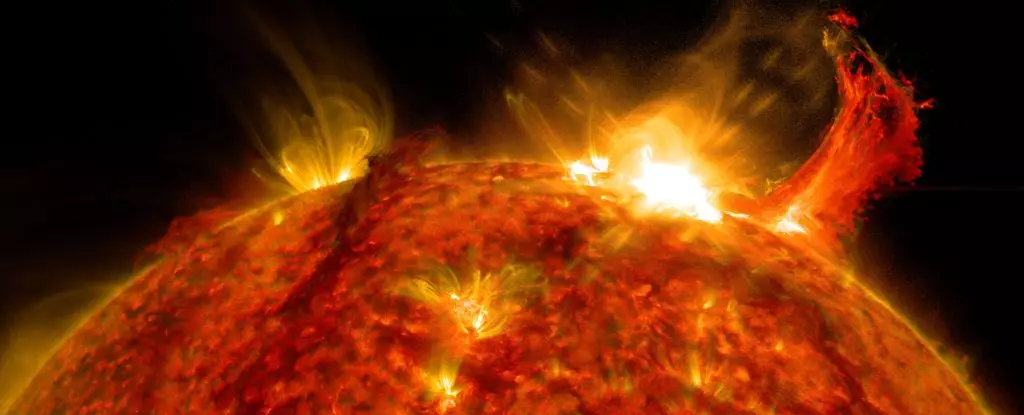Roughly 14,300 years ago, an extraordinary cosmic event served as a potent reminder of the Sun’s relentless energy and its capacity to influence life on Earth. This significant incident occurred around 12,350 BCE and has recently garnered attention due to groundbreaking research that meticulously analyzed ancient climate records. A combination of fossilized tree trunks and glacial ice samples revealed a surge of carbon-14, hinting at a solar barrage far mightier than any witnessed in modern history. Such revelations deepen our understanding of the sun-Earth relationship and provoke contemplations about humanity’s vulnerability to cosmic phenomena.
The Punch of Solar Particle Storms
At the core of this ancient event is a geomagnetic storm—a phenomenon that typically results from a coronal mass ejection (CME), where enormous quantities of solar plasma accompanied by magnetic fields are hurled towards our planet. Upon striking Earth, this plasma can trigger a wide array of effects, including mesmerizing auroras. However, beneath the beauty lies potential chaos. Historical accounts remind us of the Carrington Event in 1859, where telegraph systems worldwide suffered catastrophic failures. This was just a taste of what solar activity could unleash when it overwhelms our technological defenses.
What makes the findings about the 12,350 BCE event particularly alarming is its estimated intensity, which is believed to surpass every recorded storm by a staggering margin—over 500 times the ferocity of the 2005 storm that prompted only minor disruptions. Such a cosmic hurricane fundamentally alters our perception of solar threats, underscoring the possibility that we are utterly unprepared for a similar event in our era.
Deciphering the Carbon-14 Mystery
The connection between geomagnetic storms and carbon-14 is where the story becomes intriguingly complex. Cosmic particles, particularly those unleashed by solar activity, interact with atmospheric elements to create this radioactive isotope, which is absorbed by living organisms. Scientists use the decay rate of carbon-14 to date ancient specimens, allowing for timelines to be established for past events rooted deep in Earth’s history.
Recent studies have shown that the spike in carbon-14 within tree rings can pinpoint dates of past geomagnetic storms with remarkable accuracy. By applying a specialized climate-chemistry model named SOCOL:14C-Ex, researchers have successfully ventured back in time, analyzing the environmental conditions of long-ago Earth. This innovative methodology aids in interpreting data from glacial climates—an essential adjustment, given that previous determinative models were constrained to the Holocene epoch, which spans a relatively stable climatic period of about 12,000 years.
Redefining Extreme Solar Events
One may wonder how researchers differentiate this ancient solar event from others documented over the millennia. Events such as those occurring in 774 CE, 994 CE, and even 660 BCE have been cataloged, but the intensity of the 12,350 BCE storm is unparalleled and unique. The exceptional conditions of the era—the transition from glacial settings to warmer climates—serve to enhance the significance of this discovery. Dr. Kseniia Golubenko, a space physicist at the University of Oulu, emphasizes this by pointing out that it marks a severe outlier in our understanding of solar activity, effectively setting a new precedent for what we now regard as “extreme” solar events.
The ramifications are profound. With wild solar storms lurking within a star that fuels our existence, we need to grapple with the reality that while these cosmic events shape our planet’s history, they also pose a recurring threat to modern civilization. A glimpse into the past demonstrates not only our geological resilience but also exposes the myriad vulnerabilities of our advanced, technology-driven lifestyle. As we advance toward a future teeming with connectivity and reliance on technology, the possibility of another massive solar storm looms larger than ever, reminding us that we must be vigilant stewards of our technological ecosystems.
The Call to Action for the Modern World
Given that these ancient solar events have now been confirmed, we are faced with a moral imperative to develop strategies for fortifying our technological infrastructure against solar storms. This isn’t merely a scientific curiosity but a potentially life-altering reality that could impact global communications, power grids, and even our daily lives. A better understanding of cosmic phenomena must be paralleled with concrete steps to safeguard humanity against the unyielding forces of nature.
The 12,350 BCE event reminds us that the cosmos harbors surprises far beyond our understanding. As we stand on the precipice of a new age of solar awareness, the imperative for global cooperation in disaster preparedness cannot be understated. Let us harness our technical skills and scientific insights to bolster societal resilience against cosmic forces before the fury descends upon us again.


Leave a Reply